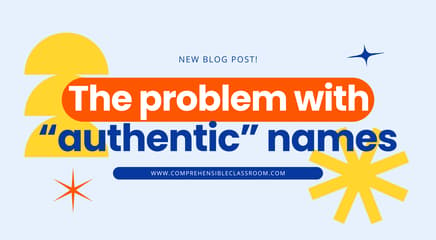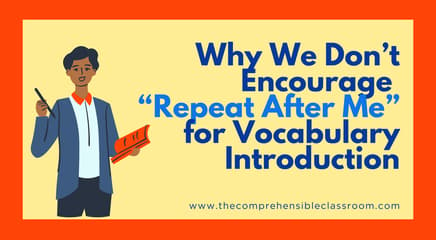When I first began practicing Teaching Proficiency through Reading and Storytelling (TPRS), I was taught to circle, and many of my early training experiences in my Professional Learning Community in Alaska involved focusing on Circling in coaching circles. As pure TPRS has blossomed into the broader Comprehension-based teaching used by language teachers around the world, circling has grown and changed as well.

WHAT IS CIRCLING?
Circling is the instructional practice of asking a series of prescribed questions in the target language about a statement in the target language. For example:
- Toni wants a cat.
- Does Toni want a cat?
- Does Toni want a cat or a dog?
- Does Toni have a cat?
- Who wants a cat?
In this example, all four questions are circling around the information provided in original statement, "Toni wants a cat."
WHY WE CIRCLE
Circling is used to help students understand and process an utterance in the target language. In doing so, this strategy provides students with contextualized repetitions of the linguistic structures contained in the utterance. A repetition is an instance in which a language learner understands a structure when she or he hears it or reads it.
When I first began training in TPRS, I was often told that the purpose of circling is to provide students with repetitions of the vocabulary words or phrases being used in the lesson. As time has gone on and my own practice has matured, so has my understanding of the purpose of circling.
I do not use circling for the purpose of providing repetitions; I use circling for the purpose of comprehension.
For that reason, you will more often hear me refer to the act of circling as "Asking processing questions".
Watch this video to learn everything you could ever want to know about Circling:
HOW TO CIRCLE
In a nutshell: Begin by making a statement in the target language. The statement should contain only ONE new target structure (vocabulary term or phrase), and the rest of the statement should be completely comprehensible to students (previously acquired vocabulary, cognates, and proper nouns). Follow it up with yes/no, either/or, and open-ended questions, and restate/recast the original statement after the answer to each question is given.
Read through this example. The explanation of each step is in the right-hand column.

CIRCLING IN PRACTICE
Once a teacher has acquired the practice of circling, it is no longer necessary for him or her to ask EVERY question about EACH component of a statement. If we were to do this every time that we made a statement, students would quickly become disengaged. Once the teacher has acquired the practice of circling, the next step is to develop discretion: learning how to balance the number and variety of questions asked with the engagement level of students. To reduce the need to ask so many questions about a single statement (to get a high number of repetitions of a Core Vocabulary word from a single statement), use strategies like Personalized Questions and Answers and Storyasking that use the Core Vocabulary many times in different statements. Instead of trying to elicit 20 repetitions from 1 statement, you can strive for 5 repetitions from each of 4 statements. Here is a demonstration of me using circling during a story asking session in Spanish 1:
CIRCLING POSTER
I also created a poster for teachers to post in their rooms (it can be enlarged) for their own reference while developing the habit of circling. This poster was based on one used by the Coaching Team, which supports teachers at large conferences like NTPRS and iFLT, and I adapted it with permission. Place it in a location that is easily visible to YOU during typical instruction, and glance at it while you practice circling with your students to remind you of the possible questions to ask.






